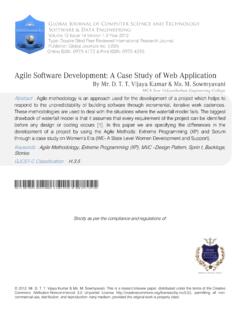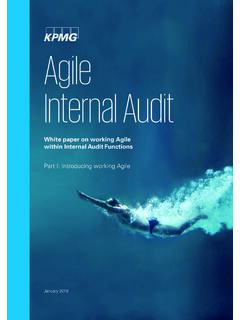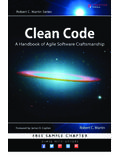Transcription of Matrix Organizations: Design for Collaboration and Agility
1 9/1/2009 Matrix Organizations: Design for Collaboration and Agility Nick Horney, & Tom O Shea, CMC, Principals, Agility ConsultingMATRIX ORGANIZATIONS Agility Consulting & Training, 2009 1 Matrix Organizations Success in a Matrix happens when you focus on building a new organization rather than simply installing a new structure. ince the end of World War II, corporate strategy has survived several generations of painful transformations and has grown appropriately agile and athletic. Unfortunately, organizational development has not kept pace, and managerial attitudes lag even farther behind.
2 As a result, corporations now commonly Design strategies that seem impossible to implement, for the simple reason that no one can effectively implement third-generation strategies through second-generation organizations run by first-generation managers. Today, the most successful companies are those where top executives recognize the need to manage the new environmental and competitive demands by focusing less on the quest for an ideal structure and more on developing the abilities, behavior, and performance of individual managers. This assessment of Matrix management, published in the Harvard Business Review in 1990, is a stinging portrayal of the state of Matrix organizations at the time the article was written.
3 Fortunately, both the times and the ability of organizations to adapt have changed. Organizations have become much more adept in implementing complex structures. However, what has not changed is the key to success in working in a Matrix correctly identified in the HBR article the abilities, behavior and performance of individual managers. This whitepaper is designed to acquaint the reader with current knowledge of Matrix organizations and the specific skills needed by you and your managers to make working in a Matrix a success. What is a Matrix ? A Matrix is an organizational structure that shares power among two or more dimensions.
4 It entails achieving a functional and product or process focus. The table below outlines the interplay between these two dimensions in a Matrix organizational structure. S ICON KEY Valuable information Exercise B Group Discussion Reading Matrix ORGANIZATIONS Agility Consulting & Training, 2009 2 Process/Product Dimension Functional Dimension Operates business processes and projects Provides resources Maintains resources capacity and capability Works cross-functionally Aligns with process/product dimension Maintains technical standards Is accountable to produce something for a customer Is accountable to support process/product dimension Is accountable to ensure resources and technical capability are available Two desired outcomes occur in Matrix structures: 1.
5 A simultaneous focus on multiple perspectives. A Matrix makes a person or unit responsive to more than one group. This introduction of multiple perspectives can be expected to improve decision quality. 2. More effective use of technical and specialized resources. Every organization has specialists who are needed by various business units. These experts are too expensive to duplicate across the organization . The Matrix allows for sharing of human resources without having one unit own them. In the literature, the terms Matrix management, project management, Matrix organization and project organization are frequently interchanged.
6 All of these terms refer to some type of cross-functional organization because they invariably involve bringing people together from two or more usually separated organizational functional areas to undertake a task on either a temporary basis (as in a project team) or on a relatively permanent basis (as in a Matrix organization ). A functional structure, for example, enables individuals to remain aware of new technical developments in their respective areas of expertise, by allowing the functional groupings to concentrate their efforts and interactions in their functional areas of interest.
7 A cost of functional structure, however, is the difficulty created in coordinating these distinct functional disciplines, task orientations and organizational localities. The product structure eliminates or reduces the coordination difficulties by concentrating everyone's attention on the requirements of the product, but at the same time such concentration makes it more difficult to stay current with developments in one's functional expertise and may result in technological obsolescence. The dilemma is that when one structure is chosen, the benefits of the other structure are lost. A Matrix combines the benefits of both structures by providing proper project coordination while maintaining a continuing linkage with a functional expertise.
8 Matrix ORGANIZATIONS Agility Consulting & Training, 2009 3 If we can distill these various ideas, a working definition of Matrix organization and project management results: cross-functional organizational overlays that create multiple lines of authority and that place people in teams to work on tasks for finite periods of time. Within this broad definition are many varieties of cross-functional organization form. One key to understanding the distinctions is the time element. Project management forms probably have the most finite time frame. A project has a deadline and definable costs and standards within that time frame.
9 Project organizations are an extension of project management, and they come into play as an organization finds itself continually managing multiple projects. The relationship between Matrix management and Matrix organization is similar in that Matrix management is a more temporary application than Matrix organization . And the distinction between Matrix and project is that project structures form around specific finite tasks, such as a construction project, whereas Matrix structures tend to form around ongoing tasks, such as managing an engineering consulting firm or manufacturing a complex product ( , aerospace companies).
10 Overall, then, these cross-functional organization forms have a great deal in common--an overlay on the traditional hierarchy, multiple lines of authority, and teams working on tasks for finite time periods. A primary advantage of the cross-functional structure is that it solves an information processing problem. It creates lateral communications channels not available in the classical bureaucratic form of organization . At the same time, the cross-functional structure reduces the need for vertical communication by creating self-contained task teams focused on a specific, finite project. It improves communication among different departments and projects by forcing managers to maintain close contact with all organizational groups upon whose support they must rely for project success.










